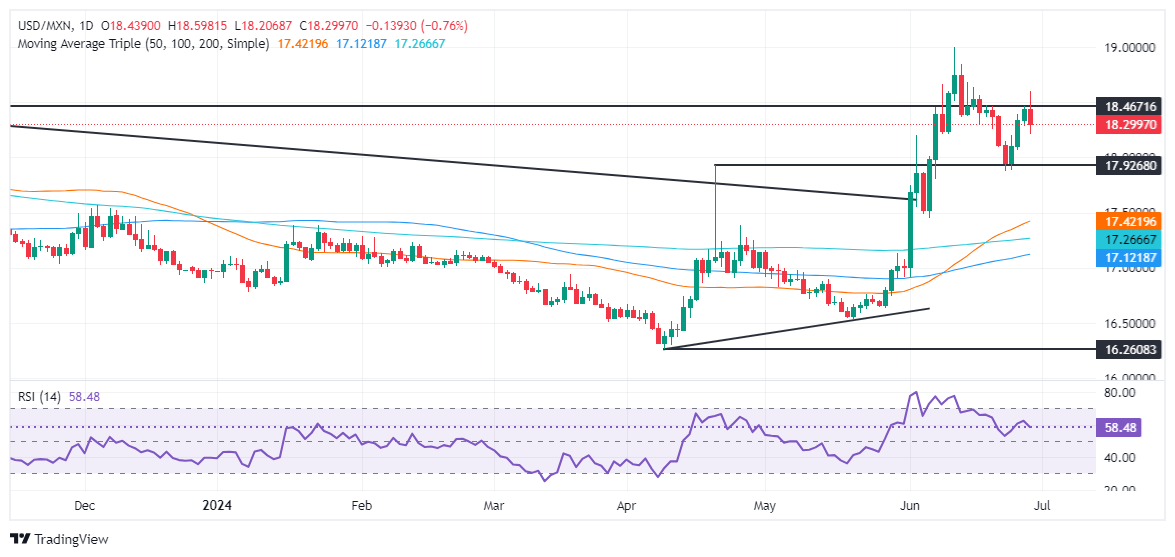Mexican Peso stages comeback to rally post-Banxico decision
- Mexican Peso rebounds to 18.24 vs. US Dollar following Banxico's decision to maintain 11.00% rate.
- Decision aligned with recent inflation data, targeting 3% inflation by Q4 2025.
- Inflation risks heightened by service sector, cost pressures, Peso fall and geopolitical tensions.
The Mexican Peso recovered ground against the US Dollar and rallied more than 1% on Friday after the Bank of Mexico (Banxico) decided to keep rates unchanged due to “idiosyncratic factors” and the Peso’s depreciation following the June 2 general election results. The USD/MXN trades at 18.24 after hitting a daily high of 18.59.
Banxico left a lifeline to the battered Peso on Thursday, holding rates at 11.00% after inflation reaccelerated, according to June’s mid-month inflation data.
The Mexican institution expects headline inflation to converge to the bank’s 3% target by Q4 2025 and acknowledged that inflation risks are skewed to the upside due to high services inflation, cost pressures, Mexican Peso depreciation and geopolitical conflicts.
Across the border, the US Federal Reserve’s (Fed) preferred inflation gauge came as expected by the consensus, showing an improvement in headline and core Personal Consumption Expenditures (PCE) Price Index.
The data failed to underpin the Greenback, which remains pressured, losing some 0.16% as revealed by the US Dollar Index (DXY). Therefore, the USD/MXN might continue on the back foot toward the remainder of the day as sellers eye an April 19 high of 18.15.
Daily digest market movers: Mexican Peso strengthens after Banxico hold
- Banxico’s decision was not unanimous and was perceived as dovish as Deputy Governor Omar Mejia Castelazo opted for a quarter of a percentage rate cut.
- Mexico’s central bank monetary policy statement highlighted the Governing Board expects the disinflation process to evolve and added that “Looking ahead, the board foresees that the inflationary environment may allow for discussing reference-rate adjustments.”
- A Citibanamex survey showed economists priced out fewer rate cuts by the central bank. They also revised the Gross Domestic Product (GDP) for 2024 downward from 2.2% to 2.1% YoY and expect the USD/MXN exchange rate to finish the year at 18.70, up from 18.00 previously reported.
- US PCE was lower than April’s 0.3% and was 0% MoM as expected. Core PCE expanded by 0.1% MoM as estimated, which is also beneath the previous reading of 0.3%.
- US Consumer Sentiment final reading for June of 68.2 deteriorated compared to May’s 69.1, yet improved as the preliminary reading was 65.8. Inflation expectations remained steady in the short and long periods at 3%.
- CME FedWatch Tool shows odds for a 25-basis-point Fed rate cut at 59.5%, unchanged from the previous day.
Technical analysis: Mexican Peso climbs as USD/MXN tumbles below 18.30
The USD/MXN is undergoing a pullback after hitting a daily high of 18.59 earlier in the day, opening the door to challenging key support levels. From a momentum standpoint, sellers are gathering some steam. This is depicted by the Relative Strength Index (RSI) pointing downward though still remaining bullish, suggesting the pullback could be short-lived.
For a bearish continuation, sellers need to reclaim the April 19 high turned support at 18.15, which would pave the way toward 18.00. The next support would be the 50-day Simple Moving Average (SMA) at 17.37 before testing the 200-day SMA at 17.23.
On the other hand, if buyers achieve a decisive break above the psychological 18.50 level, the next stop would be the year-to-date (YTD) high of 18.99, followed by the March 20, 2023, high of 19.23.

Mexican Peso FAQs
The Mexican Peso (MXN) is the most traded currency among its Latin American peers. Its value is broadly determined by the performance of the Mexican economy, the country’s central bank’s policy, the amount of foreign investment in the country and even the levels of remittances sent by Mexicans who live abroad, particularly in the United States. Geopolitical trends can also move MXN: for example, the process of nearshoring – or the decision by some firms to relocate manufacturing capacity and supply chains closer to their home countries – is also seen as a catalyst for the Mexican currency as the country is considered a key manufacturing hub in the American continent. Another catalyst for MXN is Oil prices as Mexico is a key exporter of the commodity.
The main objective of Mexico’s central bank, also known as Banxico, is to maintain inflation at low and stable levels (at or close to its target of 3%, the midpoint in a tolerance band of between 2% and 4%). To this end, the bank sets an appropriate level of interest rates. When inflation is too high, Banxico will attempt to tame it by raising interest rates, making it more expensive for households and businesses to borrow money, thus cooling demand and the overall economy. Higher interest rates are generally positive for the Mexican Peso (MXN) as they lead to higher yields, making the country a more attractive place for investors. On the contrary, lower interest rates tend to weaken MXN.
Macroeconomic data releases are key to assess the state of the economy and can have an impact on the Mexican Peso (MXN) valuation. A strong Mexican economy, based on high economic growth, low unemployment and high confidence is good for MXN. Not only does it attract more foreign investment but it may encourage the Bank of Mexico (Banxico) to increase interest rates, particularly if this strength comes together with elevated inflation. However, if economic data is weak, MXN is likely to depreciate.
As an emerging-market currency, the Mexican Peso (MXN) tends to strive during risk-on periods, or when investors perceive that broader market risks are low and thus are eager to engage with investments that carry a higher risk. Conversely, MXN tends to weaken at times of market turbulence or economic uncertainty as investors tend to sell higher-risk assets and flee to the more-stable safe havens.

